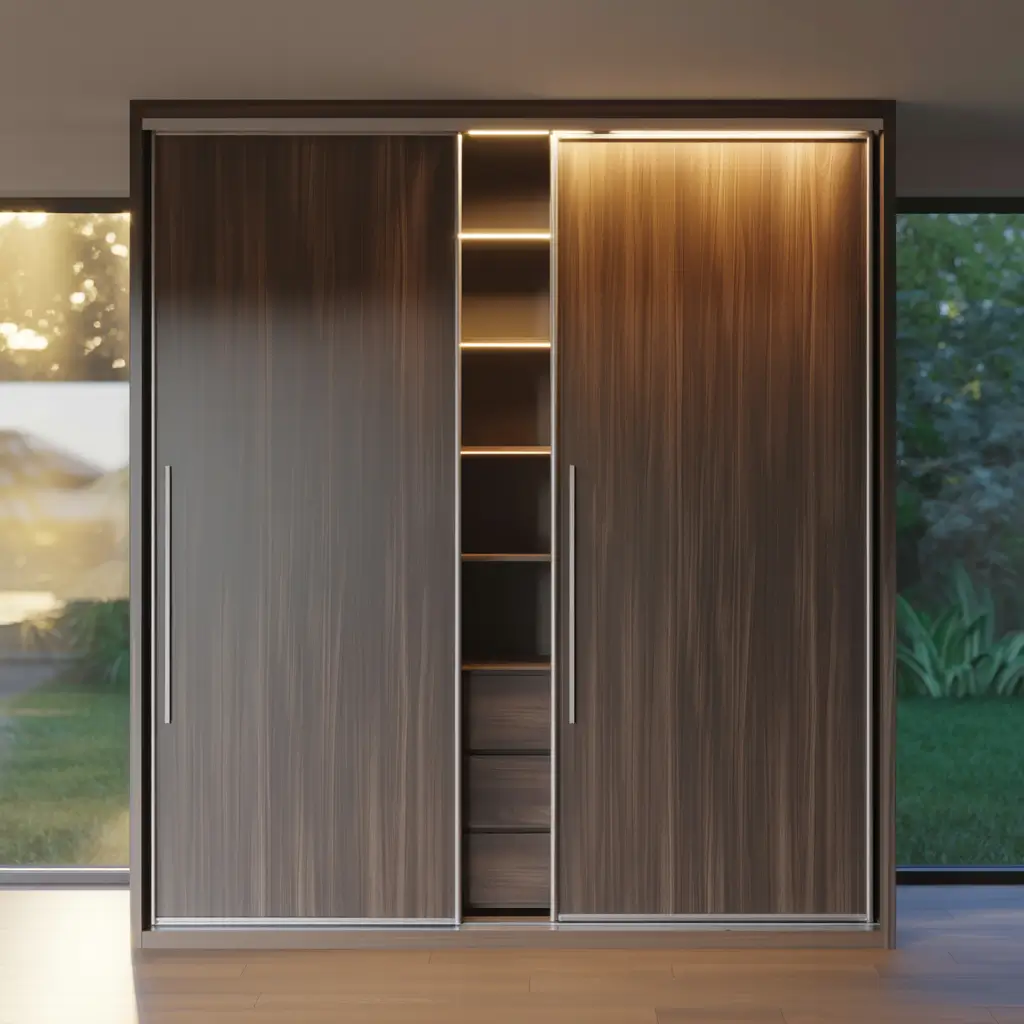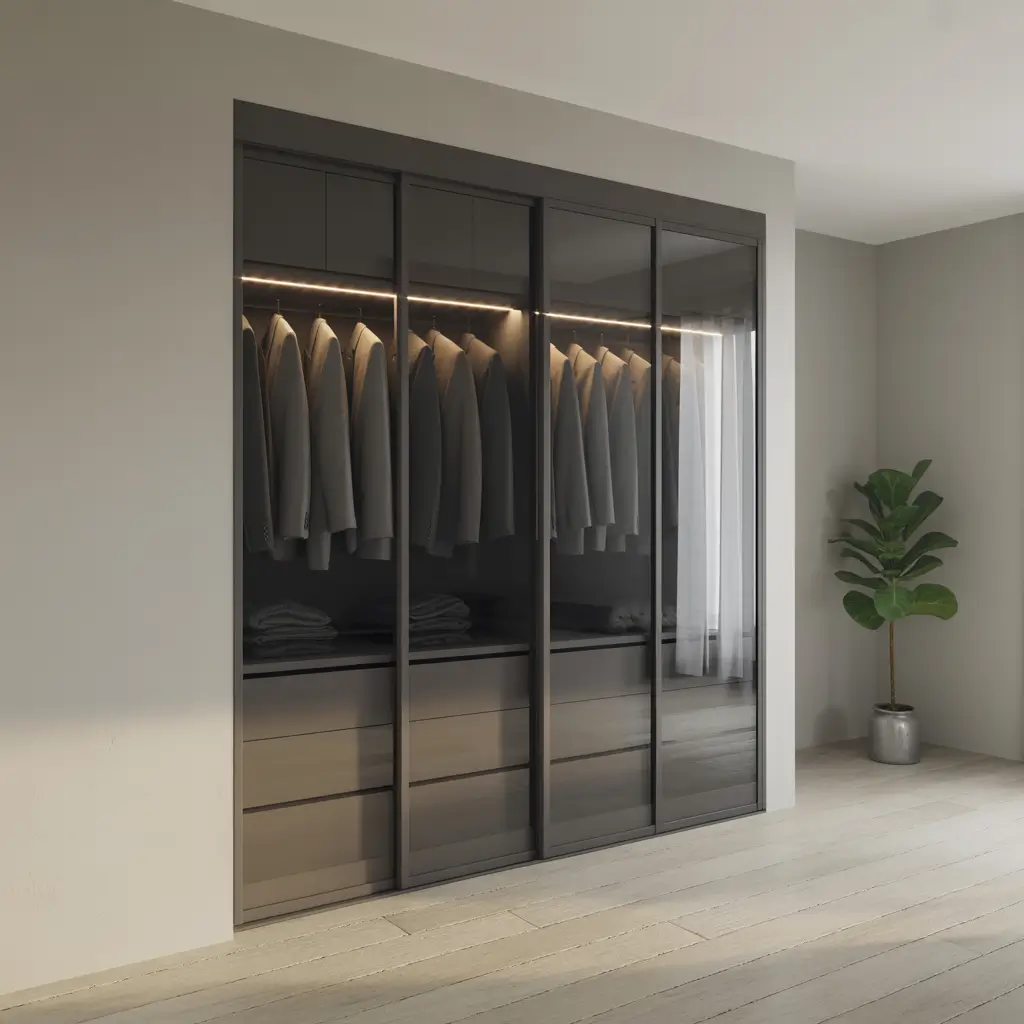15 Brilliant Tiny Hallway Ideas for Small Spaces Magic
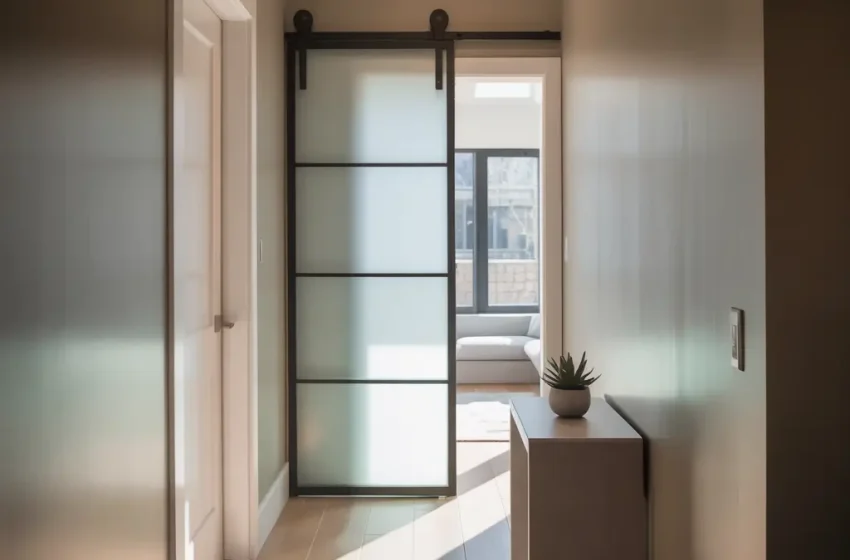
Look, we need to talk about that narrow strip of space you walk through every single day. You know, that forgotten corridor that’s basically become a dumping ground for shoes, coats, and random Amazon packages? Yeah, that one.
I spent years treating my hallway like it didn’t exist – until I realized this tiny space was actually the first thing guests saw when entering my home. Talk about making terrible first impressions! After transforming my own 3-foot-wide nightmare into something actually functional (and dare I say, Instagram-worthy?), I’ve become somewhat obsessed with small hallway solutions.
So grab your coffee, because I’m about to share 15 game-changing ideas that’ll turn your cramped corridor into something you’ll actually want to show off. Trust me, your hallway deserves better than being a glorified obstacle course.
Minimalist Floating Shelf Entry

Let’s kick things off with my personal favorite – the floating shelf system. I installed three staggered shelves in my entryway last year, and honestly? Complete game-changer.
The beauty of floating shelves lies in their simplicity. They don’t eat up floor space (which you probably don’t have anyway), yet they provide surprising storage capacity. I keep my keys, mail sorter, and a small succulent on mine – nothing groundbreaking, but it beats throwing everything on the floor.
Installation Tips That Actually Matter
Here’s what nobody tells you about floating shelves in tiny hallways:
- Mount them at eye level or higher – you don’t want to smack your head every morning
- Choose shelves no deeper than 6 inches for narrow spaces
- Stagger heights for visual interest (and to fit different items)
- Use heavy-duty anchors – trust me on this one
The minimalist approach works especially well if you’re dealing with less than 4 feet of width. Skip the ornate brackets and go for invisible mounting systems. Your walls will look cleaner, and you won’t have random metal bits sticking out to catch your sleeves on.
Slim Vertical Mirror Wall
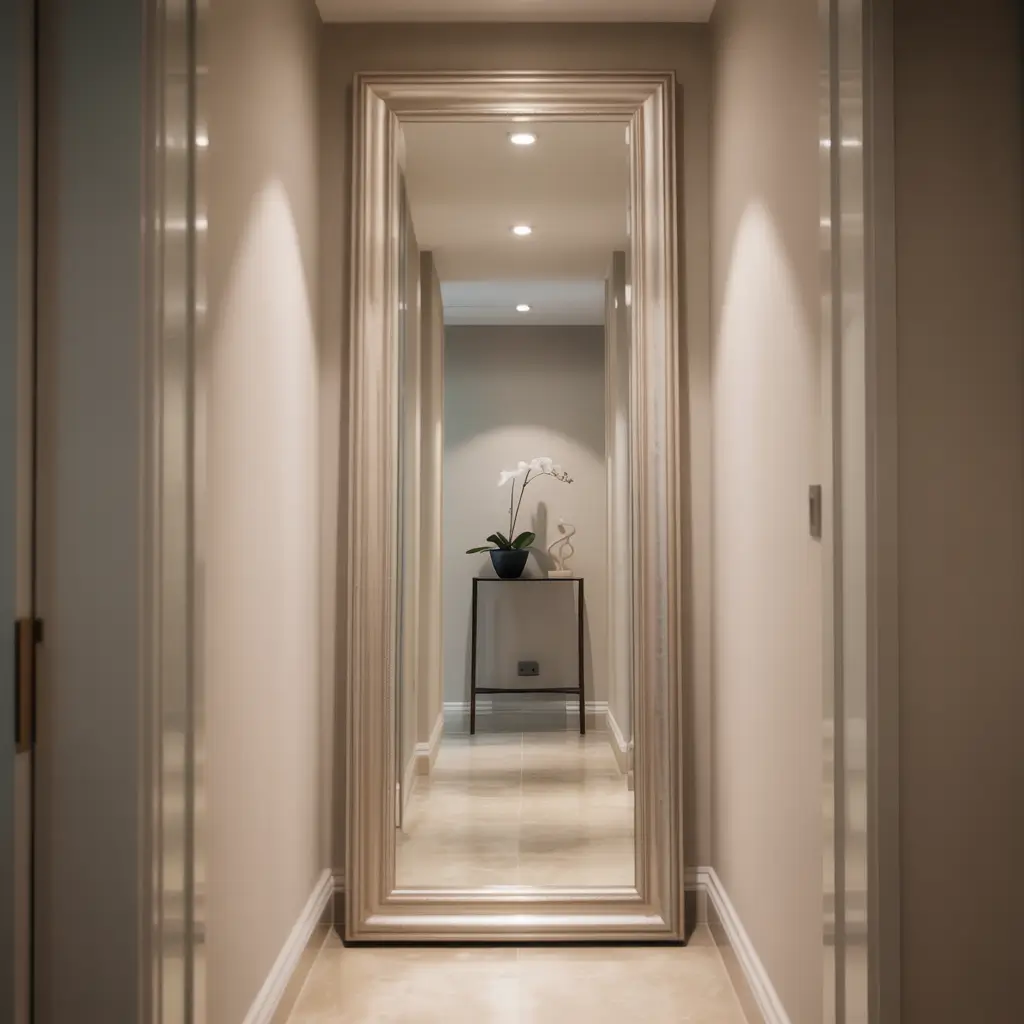
Want to know the oldest trick in the interior design book? Mirrors. But here’s the thing – vertical mirrors work magic in tiny hallways that horizontal ones simply can’t match.
I’ve tested this theory in three different apartments now. A floor-to-ceiling mirror (or even just a tall, slim one) creates this insane illusion of depth. Suddenly, your 3-foot corridor looks like it could actually fit two people walking side by side. It’s basically witchcraft.
Strategic Mirror Placement
The placement matters more than you’d think:
- Position mirrors opposite windows when possible for maximum light reflection
- Avoid placing them directly facing the front door (bad feng shui, apparently)
- Consider multiple narrow mirrors instead of one massive one
- Frame them minimally – chunky frames eat precious visual space
FYI, those cheap door mirrors from Target? They work just as well as the fancy ones from West Elm. Just saying.
Narrow Bench with Hidden Storage
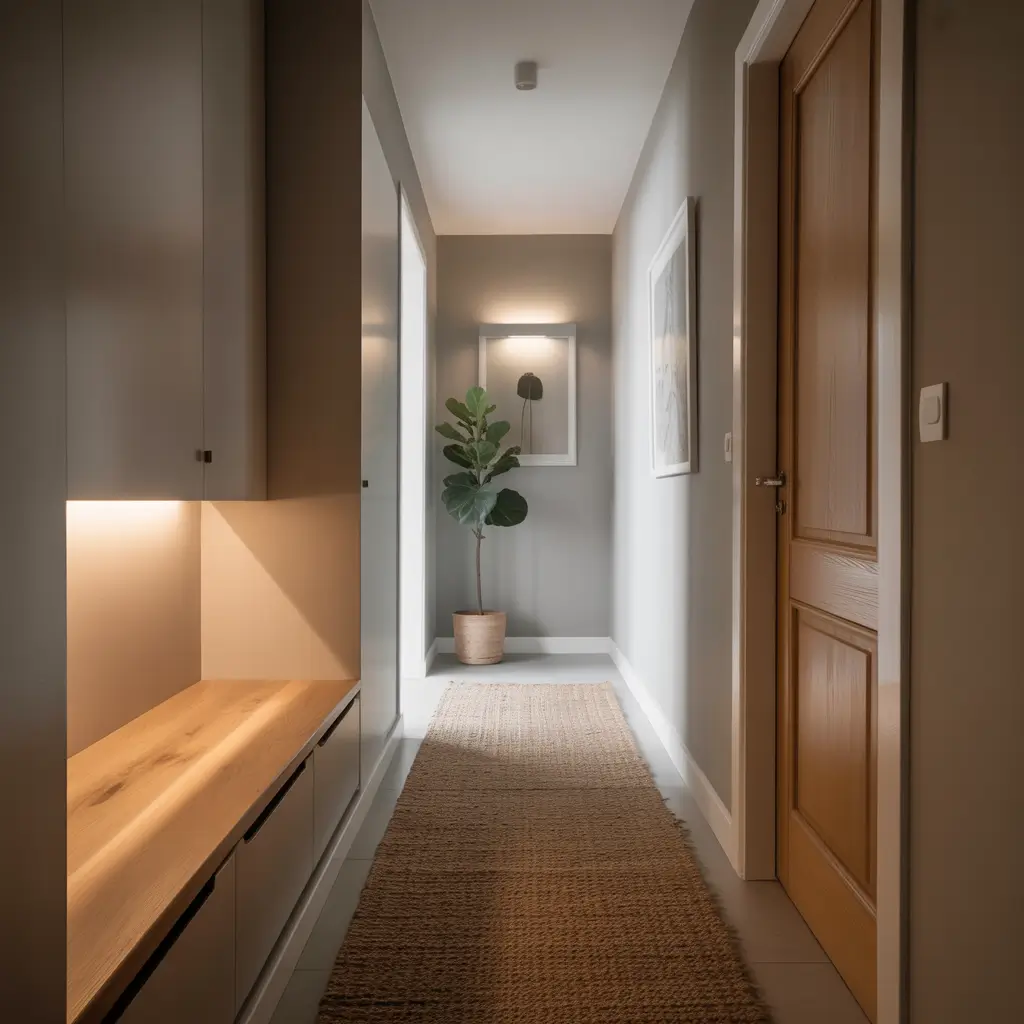
Remember when I said every inch counts? Well, a narrow bench with built-in storage is basically the Swiss Army knife of hallway furniture. You get seating AND storage in roughly 15 inches of depth.
I built mine from an IKEA hack (naturally), and it holds about 12 pairs of shoes plus random winter accessories. The top cushion lifts up to reveal the storage compartment – guests have no idea they’re sitting on my shoe collection.
Making It Work in Tight Spaces
Key measurements to remember:
- 12-15 inches deep is the sweet spot for narrow hallways
- 16-18 inches high for comfortable seating
- Length depends on your space (but go as long as possible)
- Add hooks above for vertical storage continuation
The bench also serves as a landing strip for groceries, packages, and that gym bag you keep meaning to actually use. Multi-functional furniture isn’t just smart – it’s essential when you’re working with miniature spaces.
Also Read: 15 Stylish Entry Hallway Ideas for Instant Charm
Light Color Palette Hallway
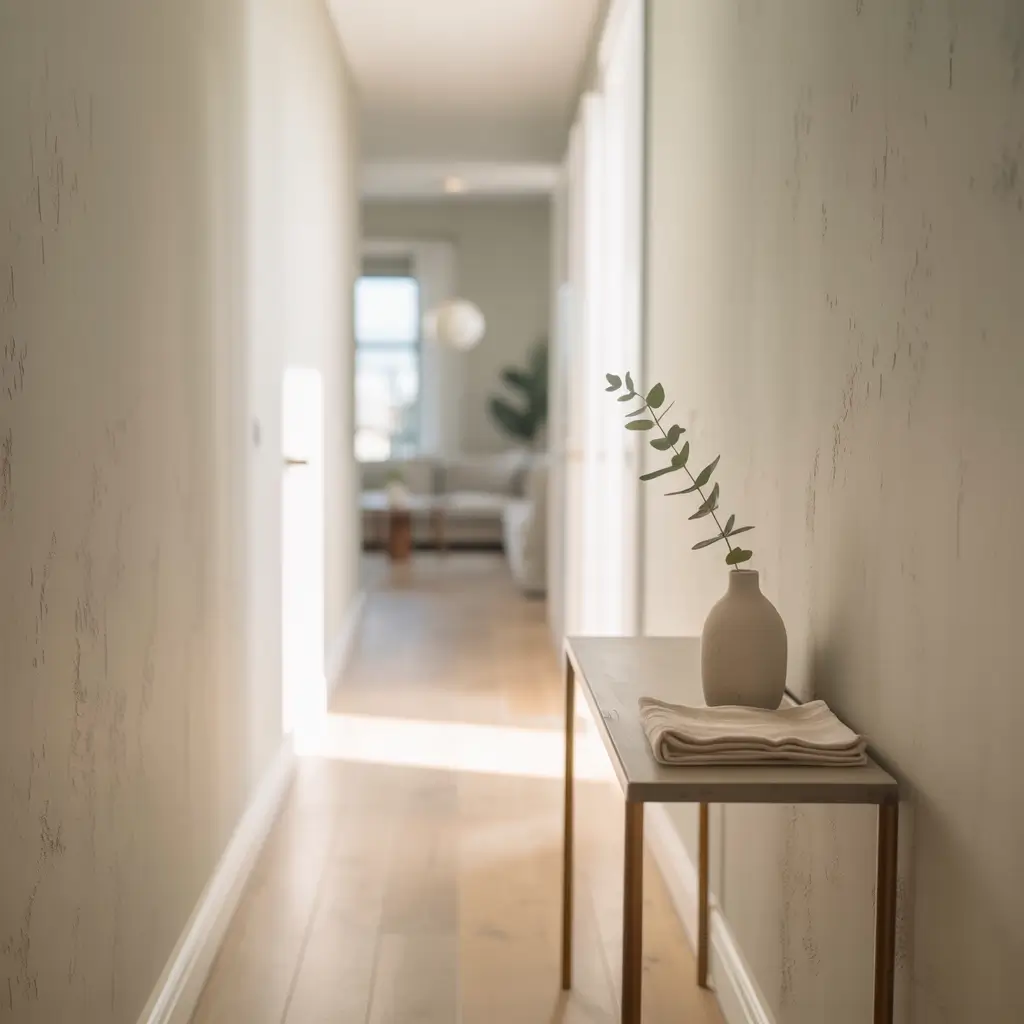
Okay, I know what you’re thinking – “groundbreaking advice, paint it white!” But hear me out. The right light color palette goes way beyond slapping some white paint on the walls.
I learned this lesson the hard way after painting my first hallway pure white. It looked like a hospital corridor. Not cute. The trick is layering different shades of light colors to create depth without darkness.
Color Combinations That Actually Work
Here’s what I’ve discovered through trial and error:
- Warm whites (with yellow or pink undertones) feel cozier than stark white
- Soft grays paired with white trim create subtle contrast
- Pale sage or mint adds personality without closing in the space
- Light wood tones warm up cool colors beautifully
Don’t forget the ceiling! Painting it the same color as your walls (or one shade lighter) makes the space feel taller. It’s a simple trick that makes a massive difference.
Wall-Mounted Coat Rack Rail

Let me tell you about the day I finally ditched my bulky coat stand. Installing a wall-mounted rail system freed up literally 2 square feet of floor space. Doesn’t sound like much? In a tiny hallway, that’s prime real estate.
The rail system I chose extends about 3 inches from the wall – just enough to hang coats without them brushing against the paint. Plus, you can customize the hook placement based on your family’s needs. More hooks for jackets in winter, fewer in summer for a cleaner look.
Installation Insights
Things to consider before drilling:
- Mount at 5.5-6 feet high for adult use
- Space hooks 6-8 inches apart minimum
- Choose hooks that fold flat when not in use
- Consider a rail with an integrated shelf on top
The best part? When it’s empty, it practically disappears into the wall. No more coat stand tumbling over when someone breathes on it wrong.
Compact Shoe Cabinet Design
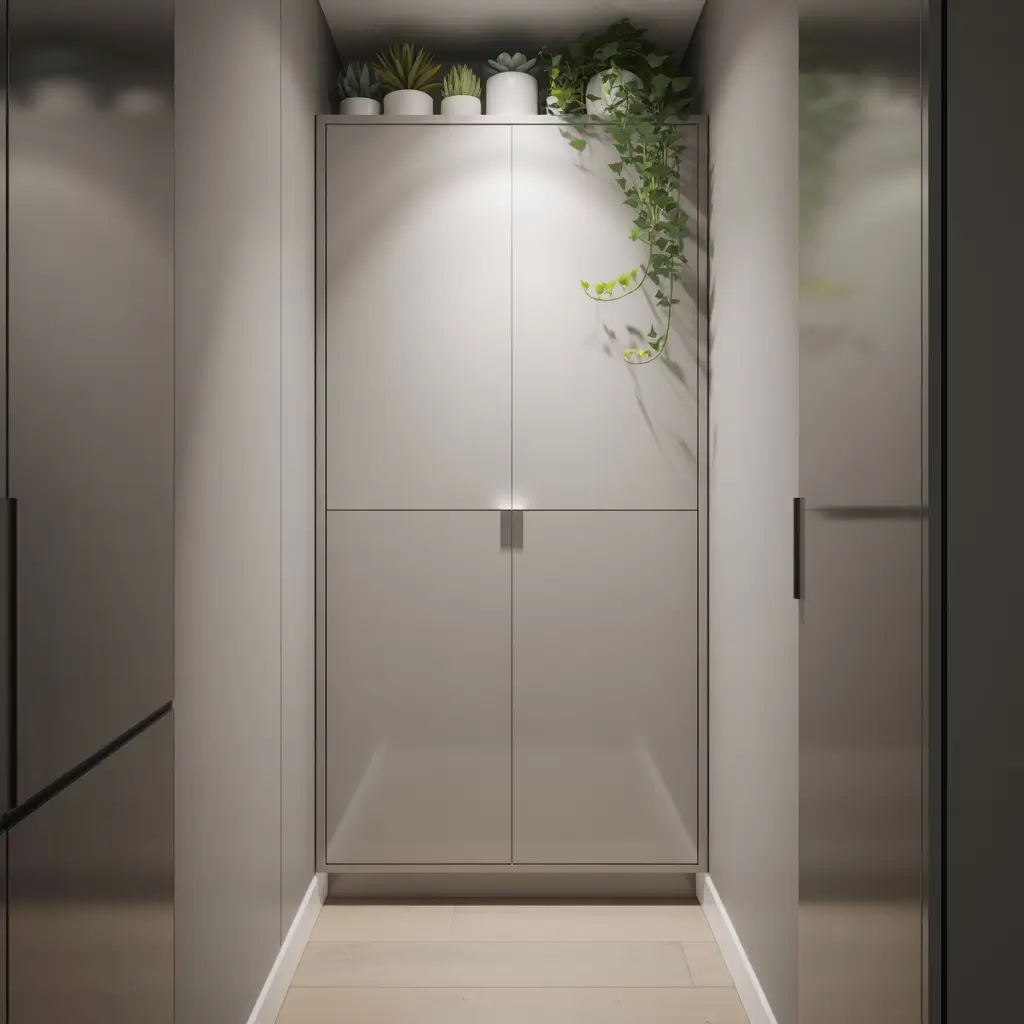
Can we talk about shoe storage for a second? Because shoes are literally the biggest hallway villain. They multiply like rabbits and somehow always end up in a pile by the door.
Enter the slim shoe cabinet – my solution to the chaos. Mine’s only 6 inches deep but holds 8 pairs of adult shoes. The tilting compartments mean shoes store at an angle, maximizing space while keeping everything accessible.
Choosing the Right Cabinet
What to look for:
- Maximum 7 inches deep for truly narrow spaces
- Tilting or pull-down compartments over traditional shelves
- Ventilation holes (because nobody wants smelly shoe storage)
- Top surface that doubles as a console table
I added small labels inside each compartment (work shoes, running shoes, etc.) and honestly? It’s been life-changing. My partner actually puts shoes away now. Miracles do happen 🙂
Also Read: 15 Stunning Sage Green Hallway Ideas for Fresh Home Vibes
Over-the-Door Storage Hooks
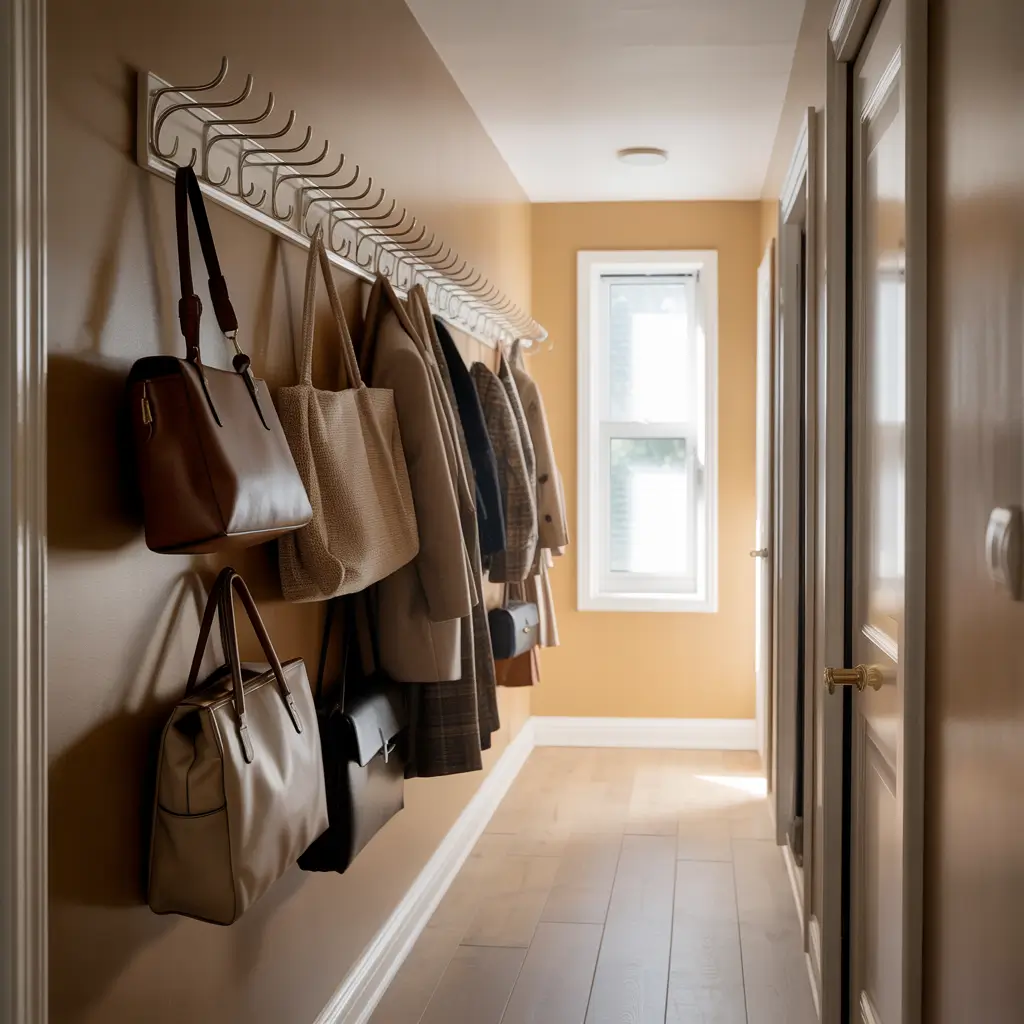
Behind every door lies untapped storage potential. Over-the-door organizers might not be revolutionary, but they’re seriously underutilized in hallways.
I’ve got one on my coat closet door that holds everything from umbrellas to reusable shopping bags. Zero floor space required, completely hidden when the door’s closed. It’s basically free storage.
Smart Hook Solutions
Best items for over-door storage:
- Slim profile hooks (not those bulky metal ones)
- Canvas organizers for mail and keys
- Shoe pockets for… well, shoes
- Grid systems for customizable storage
Just make sure your door can actually close with the hooks installed. I learned this the hard way after buying hooks that were too thick. Measure twice, buy once, people.
Narrow Runner Rug Styling

A good runner rug does three things in a tiny hallway: defines the space, adds warmth, and protects your floors. But choosing the wrong one makes your hallway feel even smaller.
After trying approximately 47 different rugs (slight exaggeration), I’ve figured out the formula. The rug should be 4-6 inches narrower than your hallway width on each side. This creates a border that makes the space feel intentional, not cramped.
Runner Rug Rules
Key considerations:
- Low pile or flat weave rugs work best in high-traffic areas
- Patterns should run lengthwise to elongate the space
- Dark colors hide dirt but can make spaces feel smaller
- Non-slip backing is non-negotiable (safety first!)
Skip the plush, high-pile options unless you enjoy vacuuming daily. A simple geometric pattern or subtle stripe adds interest without overwhelming the narrow space.
Gallery Wall for Small Spaces
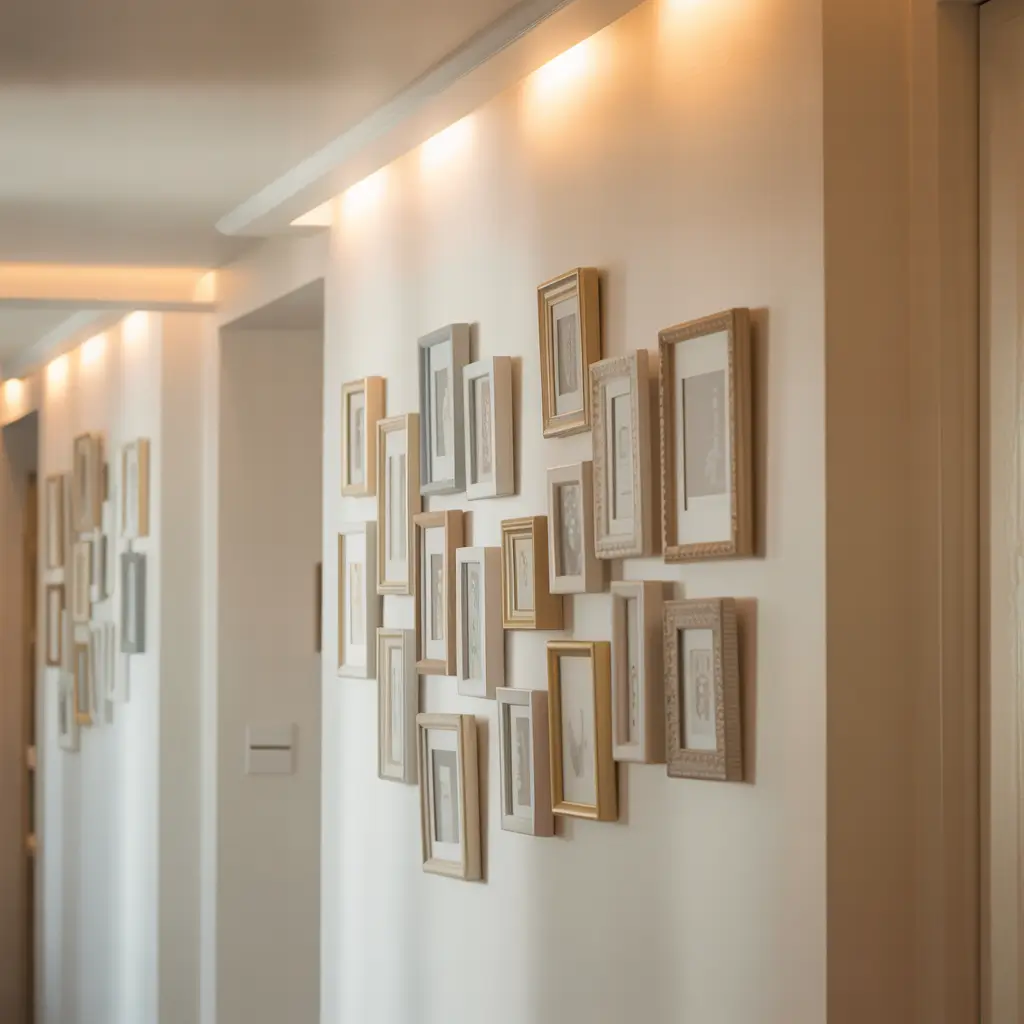
Who says tiny hallways can’t have personality? A well-planned gallery wall transforms boring corridors into mini art galleries. The key word here is “planned” – randomly hammering nails into walls rarely ends well.
I created mine using a mix of family photos, small prints, and even a tiny mirror. The trick is keeping all frames within a specific color palette (I chose black and natural wood) to avoid visual chaos.
Gallery Wall Guidelines
How to nail it (pun intended):
- Start with paper templates before hanging anything
- Keep 2-3 inches between frames
- Mix sizes but maintain balance
- Eye level is 57-60 inches from the floor
Consider using picture ledges instead of individual hanging if you like changing displays frequently. They’re basically floating shelves for art – genius for renters who hate patching nail holes.
Also Read; 15 Creative End of Hallway Decor Ideas That Wow Guests
LED Strip Lighting Hallway
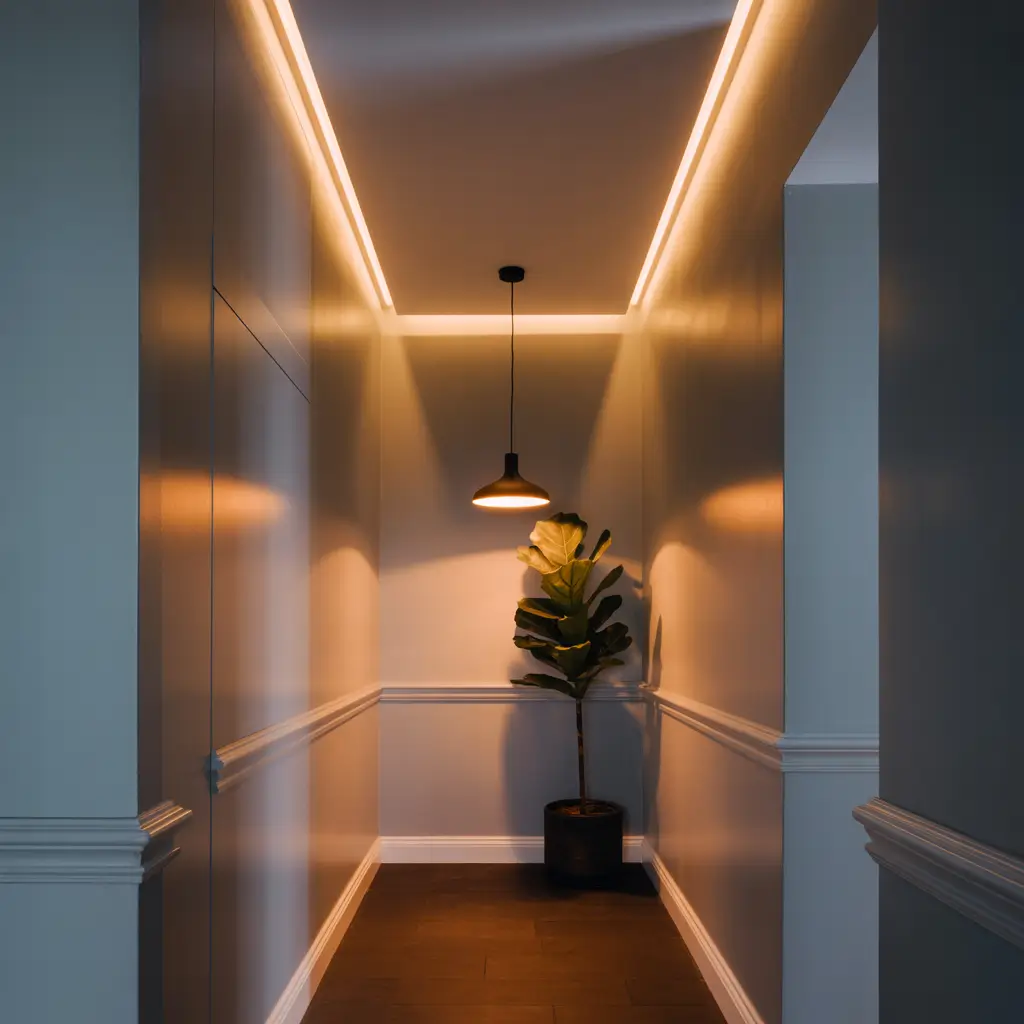
Bad lighting makes small spaces feel like caves. LED strips changed my hallway from dungeon-like to actually inviting. They’re thin, energy-efficient, and surprisingly easy to install.
I ran strips along the baseboards and under my floating shelves. The indirect lighting creates this soft glow that makes the space feel larger and way more expensive than it actually is. Total cost? Under $50.
Lighting Placement Strategy
Where to install for maximum impact:
- Under floating shelves for task lighting
- Along baseboards for ambient glow
- Behind mirrors for dramatic effect
- In recessed ceiling areas if available
Get strips with dimmer controls – bright for finding lost keys, dim for middle-of-the-night bathroom trips. The flexibility makes all the difference.
Slim Console Table Setup

A super slim console table (we’re talking 8-10 inches deep) provides surface space without blocking traffic flow. Mine holds a small lamp, key bowl, and usually whatever I’m trying to remember to take with me tomorrow.
The legs matter more than you’d think. Hairpin legs or slim metal frames keep things visually light. Chunky wooden legs, even on a narrow table, eat up visual space and make everything feel heavier.
Styling Your Console
Keep it functional but pretty:
- One statement lamp for style and lighting
- Small tray or bowl for daily essentials
- Tiny plant or fresh flowers (if you’re fancy)
- Nothing else – seriously, resist the urge to clutter
The space underneath shouldn’t be wasted either. Slide a narrow basket underneath for shoes or bags. Just keep it neat – visible under-table chaos defeats the purpose.
Multi-Functional Pegboard Wall
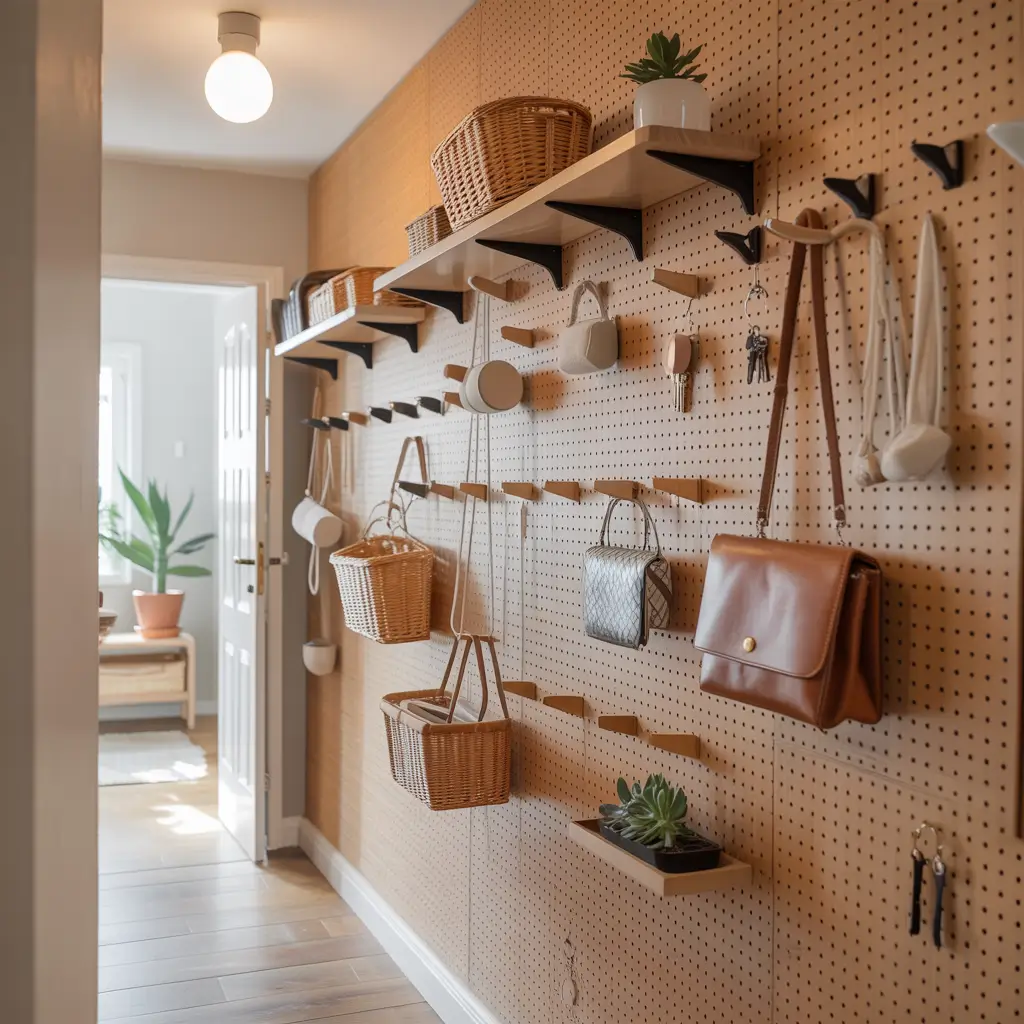
Pegboards aren’t just for garages anymore. A painted pegboard system offers completely customizable storage that changes with your needs. IMO, it’s the most versatile solution for tiny hallways.
I painted mine the same color as my walls so it blends in when empty. Add pegs, small shelves, or hooks wherever needed. Winter means more coat hooks, summer means more space for bags and hats.
Pegboard Possibilities
What you can hang:
- Adjustable hooks for coats and bags
- Small baskets for mail and keys
- Miniature shelves for decorative items
- Even small plants in hanging planters
The best part? Rearranging takes seconds. No new holes in walls, no commitment issues. It’s basically the commitment-phobe’s dream storage solution.
Tall Plants for Tight Corners

That awkward corner where the hallway turns? Perfect spot for a tall, narrow plant. Greenery brings life to sterile corridors without stealing precious walking space.
I’ve got a snake plant in mine (basically indestructible, even for serial plant killers). It’s about 5 feet tall but only takes up maybe 8 inches of floor space in its slim planter.
Plant Selection for Hallways
Best options for low-light, narrow spaces:
- Snake plants (virtually unkillable)
- Narrow bamboo in tall vases
- Tall, slim fiddle leaf figs (if you have some light)
- ZZ plants (another tough cookie)
Choose planters that are taller than they are wide. A 6-inch wide planter that’s 12 inches tall looks way better than a short, squat pot in tight spaces.
Sliding Door Hallway Upgrade
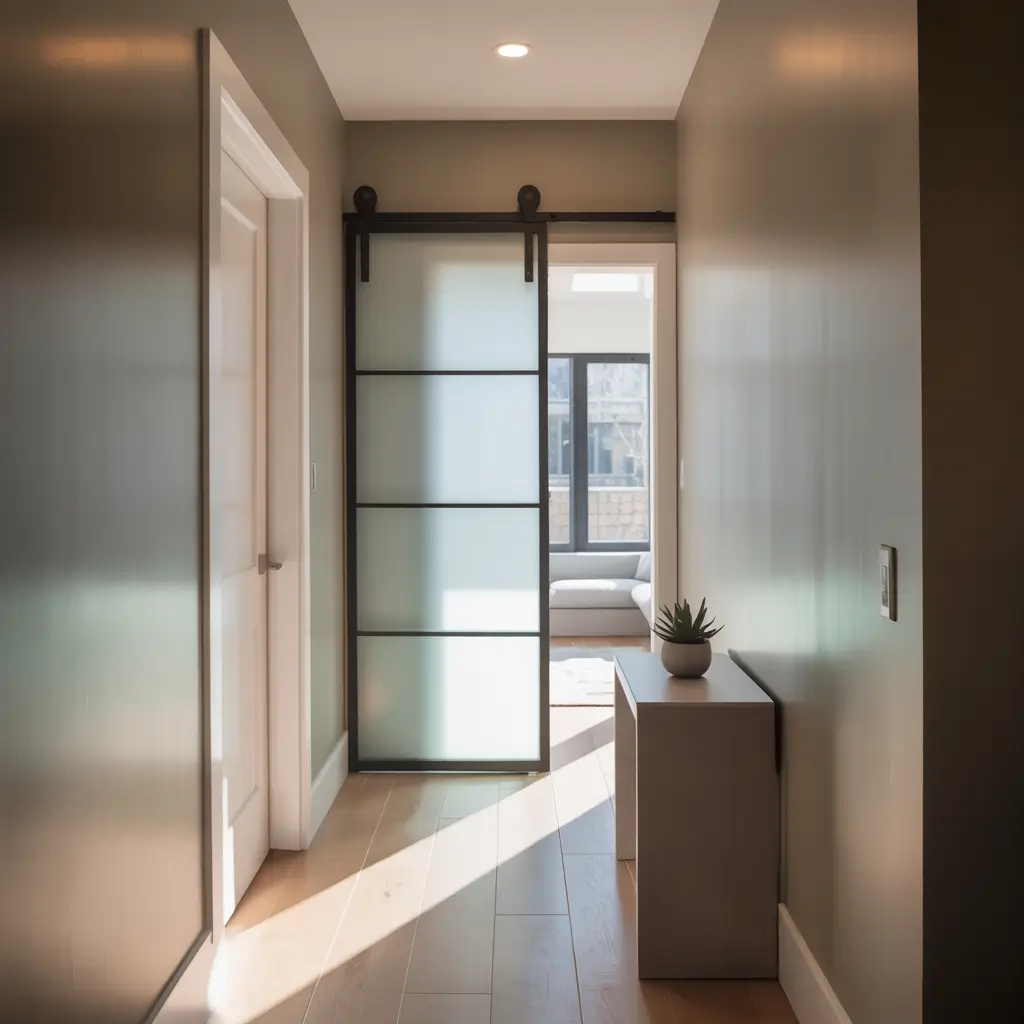
If your hallway has doorways eating up swing space, sliding doors are your new best friend. Pocket doors are ideal but not always feasible. Barn-style sliders work almost anywhere.
I replaced my bathroom door with a slider last year. Gained almost 15 square feet of usable space. That’s huge when your entire hallway is only 40 square feet total.
Sliding Door Considerations
What to think about:
- Barn doors need 2-3 inches of wall clearance
- Pocket doors require wall reconstruction
- Soft-close mechanisms prevent slamming
- Privacy locks are available for bathrooms
The hardware can get pricey, but DIY kits make it manageable. YouTube University taught me everything I needed to know about installation.
Scandinavian Tiny Hallway Look

Let’s wrap this up with the Scandinavian approach – basically the master class in making small spaces feel serene. Think white walls, natural wood, and absolutely zero clutter.
The Scandi style works because it’s inherently minimalist. Every item has a purpose, every color is intentional, and storage is hidden but accessible. It’s not about having less stuff – it’s about organizing it better.
Achieving the Scandi Vibe
Essential elements:
- White or light gray walls (obviously)
- Natural wood accents in light tones
- Simple, functional furniture pieces
- Cozy textiles in neutral colors
- Green plants for life and color
The trick is restraint. When you think you’re done decorating, remove one more thing. The negative space is just as important as what you fill it with.
Making It All Work Together
Here’s the thing about tiny hallways – you can’t use all 15 ideas at once. Pick 3-4 that solve your specific problems and commit to them fully. My combo? Floating shelves, LED strips, vertical mirror, and a narrow bench. Together, they transformed my sad hallway into a space I actually like.
Remember, the best hallway is one that works for YOUR life. Maybe you need maximum shoe storage, or perhaps you’re all about that gallery wall life. There’s no wrong answer as long as you can walk through without doing an obstacle course routine.
Start with one change and build from there. Rome wasn’t built in a day, and your perfect tiny hallway won’t be either. But trust me, when you finally nail it (literally and figuratively), you’ll wonder why you waited so long to show your hallway some love.
Now excuse me while I go reorganize my floating shelves for the third time this week. What can I say? When your hallway finally looks good, you want to keep tweaking it. Happy decorating!

